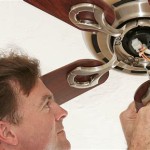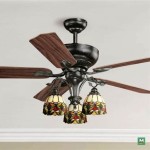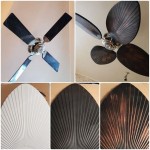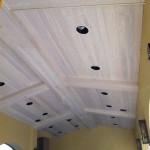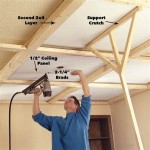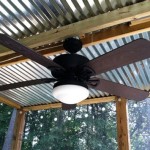False Ceiling Meaning
A false ceiling, also known as a dropped ceiling, suspended ceiling, or T-bar ceiling, is a secondary ceiling hung below the main structural ceiling. It creates a concealed plenum space between the two layers, used to house mechanical, electrical, and plumbing (MEP) services, including ductwork, piping, wiring, and other building infrastructure. False ceilings provide a cleaner, more aesthetically pleasing finish by concealing these utilities.
Beyond concealing building services, false ceilings offer several practical advantages. They contribute to thermal insulation, reducing energy consumption by creating a barrier that helps regulate room temperature. Acoustic performance can also be enhanced through the use of sound-absorbing materials within the ceiling assembly. Fire safety is another crucial aspect, with certain false ceiling materials designed to resist fire spread and compartmentalize smoke.
The construction of a false ceiling typically involves a grid system suspended from the main ceiling by wires or rods. This grid supports lightweight panels or tiles that form the visible surface of the false ceiling. The grid system often consists of interconnected metal channels or T-bars, which give the "T-bar ceiling" its name. Access panels can be incorporated into the design to allow easy access to the plenum space for maintenance and repairs.
A variety of materials are used in the construction of false ceilings, each offering specific benefits. Gypsum board is a common choice due to its affordability, fire resistance, and ease of installation. Mineral fiber tiles are another popular option, valued for their acoustic performance and availability in various textures and patterns. Metal panels are often chosen for their durability and sleek aesthetic, while wood panels offer a more natural, decorative look.
The selection of a false ceiling material should be based on the specific requirements of the space. Factors to consider include the desired aesthetic, acoustic performance, fire rating, budget, and maintenance requirements. For example, in a noisy office environment, acoustic tiles might be prioritized, while in a fire-prone area, fire-rated gypsum board would be a more suitable choice.
Different types of false ceilings cater to various design and functional needs. The most common type is the modular suspended ceiling, featuring a grid system and removable panels. This allows for easy access to the plenum and simplifies maintenance. Stretch ceilings, made of a flexible PVC membrane, offer a seamless and modern look. Coffered ceilings, characterized by recessed panels or coffers, create a more ornate and traditional aesthetic.
The installation process of a false ceiling generally begins with establishing the desired height of the dropped ceiling. Suspension wires or rods are then fixed to the main ceiling, followed by the installation of the grid system. Ceiling panels or tiles are then placed within the grid, completing the installation. Precise measurements and careful planning are crucial for a successful and aesthetically pleasing result.
Proper maintenance is essential for preserving the functionality and appearance of a false ceiling. Regular inspection and cleaning of the ceiling panels and grid system can prevent the accumulation of dust and debris. Damaged or stained panels should be replaced promptly to maintain the overall aesthetic and integrity of the ceiling. Access panels should be checked regularly to ensure they are functioning correctly.
False ceilings play a significant role in modern building design, contributing to both aesthetics and functionality. They offer a versatile solution for concealing building services, improving acoustic performance, enhancing thermal insulation, and meeting fire safety requirements. The choice of material, type, and installation method depends on the specific needs and characteristics of the space. Understanding the diverse aspects of false ceilings allows for informed decisions that optimize building performance and aesthetic appeal.
Beyond the standard rectangular grid layouts, advancements in technology and design now offer greater flexibility in false ceiling configurations. Curved profiles and custom shapes can be achieved, enabling architects and designers to create unique and visually striking ceiling designs. This allows for integration with lighting systems and other architectural elements, further enhancing the aesthetic potential of false ceilings.
The integration of lighting within false ceilings offers considerable design versatility. Recessed lighting fixtures, track lighting, and pendant lights can be seamlessly incorporated, providing both functional illumination and aesthetic enhancement. The placement and type of lighting can be strategically planned to create specific moods, highlight architectural features, or optimize the functionality of different spaces within a building.
The plenum space created by a false ceiling also offers opportunities for improved building efficiency. By acting as a return air plenum, the space can contribute to a more efficient HVAC system. Furthermore, the concealed space can be utilized for running additional services, such as data cabling and communication infrastructure, without compromising the aesthetics of the occupied space below.
In conclusion, while "in conclusion" was to be avoided, the multifaceted nature of false ceilings underscores their importance in contemporary construction. They provide a practical and adaptable solution to several design and functional challenges. The choice of material, design, and installation should be carefully considered to maximize the benefits and achieve the desired outcome.

False Ceiling Definition Benefits And Various Types Happho

Types Of False Ceilings And Its S The Constructor

What Is False Ceiling Contractorbhai

Things To Know About A False Ceiling Avisun Properties
What Is False Ceiling Quora

Types Of False Ceilings And Its S The Constructor

Interior Designing False Ceiling

False Ceiling At Rs 50 Square Feet In Chennai Id 10393865212

False Ceilings Types Advantages And Its Materials

Things To Know About A False Ceiling Avisun Properties
Related Posts

